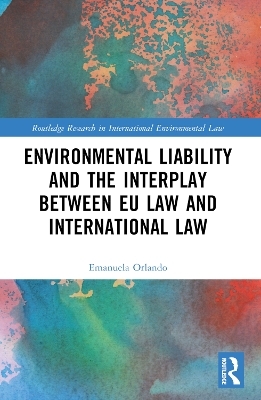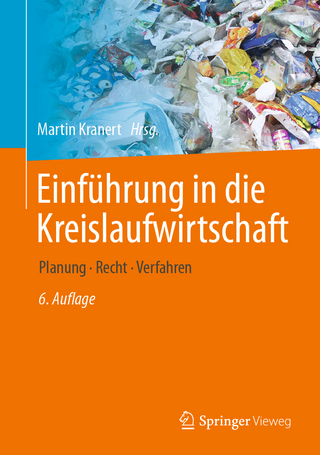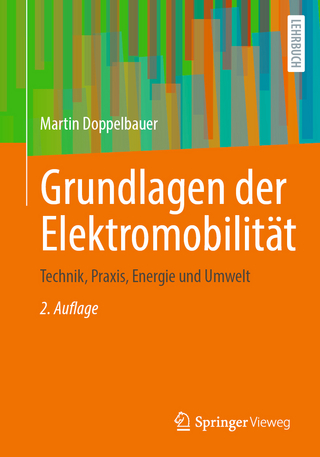
Environmental Liability and the Interplay between EU Law and International Law
Routledge (Verlag)
978-1-032-53874-7 (ISBN)
Given the book’s focus and the transnational legal dimension of the issues covered, this volume will be of great interest to legal academics and researchers working in the environmental law field from an EU law and international law perspective, as well as more generally to scholars interested in the study of the relationship between EU and international law. Outside academia, the book will also be of great interest to practitioners wishing to get insights into the application of the law of environmental liability in the EU and at the international law level.
Dr Emanuela Orlando is Lecturer in Environmental Law at the School of Law, Politics and Sociology of the University of Sussex.
Preface
Acknowledgements
Abbreviations
Introduction—relevance of the topic and scope of the analysis
1. Background: the problem
2. The concept, role and function of liability in the environmental context
3. Environmental liability and access to justice
3.1. Access to justice in environmental matters
3.2. Access to justice and environmental liability
4. From theory to practice: current developments in environmental liability
4.1. The global picture
4.2. The elusive response of international law
5. Scope and aims of this book
5.1. Theoretical background
5.2. Focus, methodological approach and structure of the book
PART 1
Environmental liability in international law
1 The law of State responsibility and its application to environmental damage
1. Introduction
2. The responsibility of States for wrongful acts: general principles
3. Transboundary harm prevention and State responsibility
3.1. Early developments and evolution of the primary rules
3.2. From no-harm to prevention
3.3. Due diligence and environmental liability
3.4. The ‘significant harm’ threshold
3.5. The link of causality
4. From transboundary harm prevention and responsibility to States’ environmental liability
4.1. The concept of environmental damage
4.2. Reparation under the law of State responsibility
4.3. Valuation and assessment of environmental damage
5. Current challenges of the law of State responsibility in the environmental context
5.1. Non-state actors and State responsibility
5.2. The erga omnes character of environmental harms
6. State responsibility for environmental harm in the international States practice
7. Concluding remarks and assessment
2 The quest towards an international law framework of states’ environmental liability in the work of the ILC
1. State liability as a primary rule of international law
2. Environmental liability in the work of the ILC: from international liability to allocation of losses
3. Response measures and ex post prevention in the environmental field: between primary and secondary rules?
4. Conclusions
3 Civil liability for environmental damage in international treaties
1. Introductory remarks
2. The international liability framework for nuclear damage
2.1. The 1960 Paris and 1963 Vienna Conventions
2.2. The role of the state in the nuclear liability regime
2.2.1. State liability under the 1963 Vienna and 1960 Paris Conventions
2.3. Revising and enhancing the international nuclear liability regime
2.3.1. The 1988 linking protocol
2.3.2. The 1997 Vienna amending protocol
2.3.3. The 1997 Convention on Supplementary Compensation (CSC)
2.3.4. The 2004 protocols amending the Paris and Brussels Conventions
2.4. The international nuclear liability framework: an assessment
3. International civil liability regimes for sea pollution damage
3.1. The 1969 civil liability convention and the 1971 fund convention
3.2. The 1992 revision protocols of the oil pollution liability framework
3.3. The definition of oil pollution damage
3.4. Revising the amount of compensation
3.5. The International Oil Pollution Compensation (IOPC) Fund
3.6. The 2003 Supplementary Fund
3.7. Oil pollution liability treaties in a multilevel context
4. Complementing the oil pollution regime: the HNS and Bunker oil liability conventions
5. The international liability framework and the protection of the marine environment
6. ‘Second generation’ environmental liability agreements
6.1. The 1993 Council of Europe’s Lugano Convention
6.2. The Nagoya-Kuala Lumpur supplementary protocol on liability for biodiversity damage
6.2.1. Liability and redress in the framework of the Biodiversity Convention
6.2.2. Liability for damage caused by LMOs
6.3. The liability annex to the Madrid Protocol on Environmental Protection
7. Conventional systems of international liability: a layered framework
8. Soft law developments in the field of environmental liability
9. Concluding remarks
PART 2
Harmonising environmental liability in the EU: Substantive and procedural legal aspects
4 The EU approach to environmental liability: The 2004/35 environmental liability directive
1. Introduction
2. Historical background
3. The underling regulatory and policy rationales
4. The Directive’s main elements and scope of application
4.1 Definition of ‘environmental damage’
4.2. The natural resources covered
4.2.1. Damage to ‘biodiversity’
4.2.2. Damage to water
4.2.3. Damage to land
4.3. A limited approach to environmental damage?
4.4. The notion of operator and the activities covered
4.5. The Directive’s temporal scope of application
4.6. Exceptions and defences under the Directive
4.7. Questions of causation and plurality of responsible parties
5. Enforcing environmental liability
5.1. Combining prevention and reparation for environmental harm
5.2. The competent authorities and the enforcement of the ELD’s liability regime
6. Remedies
7. Issues of access to justice under the ELD
8. Harmonising environmental liability in the EU: assessing the ELD and its potential added value
9. Concluding remarks
5 Transnational harm in Europe and the potential for a harmonised legal framework
1. Introduction
2. The harmonisation of conflict of law in Europe
3. The Brussels I Regulation and its application to transboundary environmental damage
4. Rome II regulation and the determination of applicable law
5. Transnational corporate litigation before domestic courts in Europe
6. Jurisdictional aspects, corporate liability and duty of care
7. The harmonisation of EU private international law rules: an assessment
8. Transboundary environmental liability litigation in Europe: perspectives after the ELD
9. The new proposal for a directive on corporate sustainability due diligence
PART 3
Exploring the interactions between EU law and international law
6 The EU’s contribution to international law-making in the field of environmental liability
1. Introduction
2. The EU’s participation in international agreements: general remarks
3. The principle of conferral and EU’s external competence
3.1. Express external competences
3.2. The doctrine of implied external powers
3.3. Choosing the appropriate legal basis
4. The practice of EU external relations
4.1. Mixed agreements
4.2. Member States acting as ‘trustees’ of the EU
5. The duty of cooperation and its impact on Member States’ external action
6. Reflections on the relationship between the EU legal order and international law
7. The participation of the EU in international environmental liability agreements
7.1. Liability agreements with an environmental dimension: the Nagoya-Kuala Lumpur Supplementary Protocol
7.2. Disrupting interaction?
7.3. The EU’s involvement in international civil liability treaties on marine pollution and nuclear damage
7.3.1. The external relations implications of Brussels I Regulation
7.3.2. The impact of the ELD on the EU’s participation in the marine pollution civil liability regime
7.4. EU’s and Member States’ ratification of international liability conventions
8. Interaction and coordination between liability regimes in a multilevel context
8.1. The practice of disconnection and non-affect clauses
8.2. Coordinating the ELD and the liability conventions on marine pollution and nuclear damage
8.3. Article 4 of the ELD
9. Environmental policy and governance perspectives on the interaction between the ELD and international law
10. Concluding remarks
7 Substantive aspects of the interplay between EU law and international environmental agreements
1. Introduction
2. The legal status and impact of international treaties to which the EU is a party in the EU legal order
2.1. The binding character of EU international agreements and the CJEU’s jurisdiction over them
2.2. Primacy of EU international agreements
3. The CJEU’s case-law and its approach to direct effect of international norms
4. Consistent interpretation
5. Towards a harmonious approach to the relationship between EU and international law
6. Consistent interpretation and the mutual supportiveness of EU law and international law in the field of environment
7. Interim findings
8. Between mutual supportiveness and complementarity in the CJEU’s case-law on environmental liability
9. Interactions and potential synergies between liability regimes in a multilevel context
Conclusions
1. An evolving scenario
2. General trends and emerging principles
3. Environmental harms and the relationship between EU and international law: towards mutual supportiveness?
4. Closing remarks
Bibliography
Index
| Erscheinungsdatum | 06.11.2024 |
|---|---|
| Reihe/Serie | Routledge Research in International Environmental Law |
| Verlagsort | London |
| Sprache | englisch |
| Maße | 156 x 234 mm |
| Gewicht | 562 g |
| Themenwelt | Naturwissenschaften ► Biologie ► Ökologie / Naturschutz |
| Recht / Steuern ► EU / Internationales Recht | |
| Recht / Steuern ► Öffentliches Recht ► Umweltrecht | |
| ISBN-10 | 1-032-53874-0 / 1032538740 |
| ISBN-13 | 978-1-032-53874-7 / 9781032538747 |
| Zustand | Neuware |
| Informationen gemäß Produktsicherheitsverordnung (GPSR) | |
| Haben Sie eine Frage zum Produkt? |
aus dem Bereich


